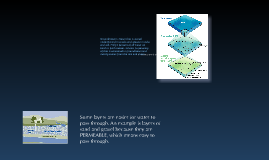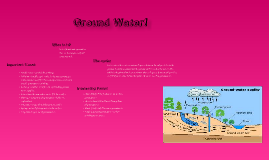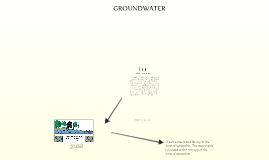Groundwater
Transcript: Groundwater Underground Layers -Water underground trickles down between particles of soil and through cracks and spaces in layers of rock. -Different types of rock and soil have different sized spaces, or pores, between their particles. -Materials that allow water to pass through easily are permeable. -Materials that water cant pass through easily are impermeable. -The area of permeable rock or soil that is totally filled, or saturated with water is called saturated zone. -The top of the saturated zone is the water table. -The layer of rocks and soil above the water table is called the unsaturated zone. Aquifers -Any underground layer of rock or sediment that holds water is called an aquifer. -Millions of people obtain water from this underground storehouse. -Groundwater may travel hundreds of kilometers and stay in an aquifer for thousands of years before coming to the surface again. -How fast it moves depends largely on how steeply the aquifer slopes and how permeable the rocks are. Bringing Groundwater to the Surface -The depth of the water table can vary greatly or even over a small area of land. More water increases the the level of the water table. -In places where the water table meets the ground surface, groundwater seeps onto the surface.The groundwater may feed a stream or pond, or form a wetland. -People can also bring groundwater to the surface. Wells -Since ancient times, people have brought groundwater to the surface for drinking and everyday use. -People can obtain groundwater from an aquifer by drilling a well below the water table. -Pumping water out of an aquifer lowers the water level near the well. If too much water is pumped out too fast, the well may run dry. -New water that enters the aquifer from the surface is called recharge. Artesian Wells -In some aquifers, groundwater is trapped between two layers of impermeable rock or sediment. -If the top layer of rock is punctured, the pressure sends water spurting through the hole. -A well in which water rises because of pressure within the aquifer is called an artesian well. Springs and Geysers -A geyser spurts out hot water. Geysers and springs are found around areas with volcanic activity. Geysers shoot up towering fountains of water from underground, they also shoot up steam. -Springs form when groundwater seeps up from the ground. Springs -Places where groundwater bubbles or flows out of cracks in the rocks are called springs. -Most springs contain water at normal temperatures, but some springs contain water that was heated by hot deep underground rocks. - The heated water bubbles to the surface in hot springs. Geysers -A geyser is a type of hot spring that shoots up water periodically into the air. -A geyser forms when very hot water that has been circulated deep underground begins to rise through narrow passages in the rock. -Heated gases and bubbles of steam are forced up these passages by pressure Some ways groundwater is polluted is... -Polluted fresh water enters a well -Improper disposal in backyard, ditches, low ground, sceptic systems, and overgrown ditches. -Over fertilization -Oil spills -Random waste disposal Ways to prevent groundwater pollution... -Sweeping the streets -Clean up abandoned industrial sites -Careful adjustment of fertilizer Facts about groundwater pollution... -Groundwater pollution can spread diseases -Groundwater is a major source of drinking water but is being polluted -Cleaning groundwater pollution is very costly -Some groundwater needs to be abandoned because it is contaminated too much Groundwater Pollution

















